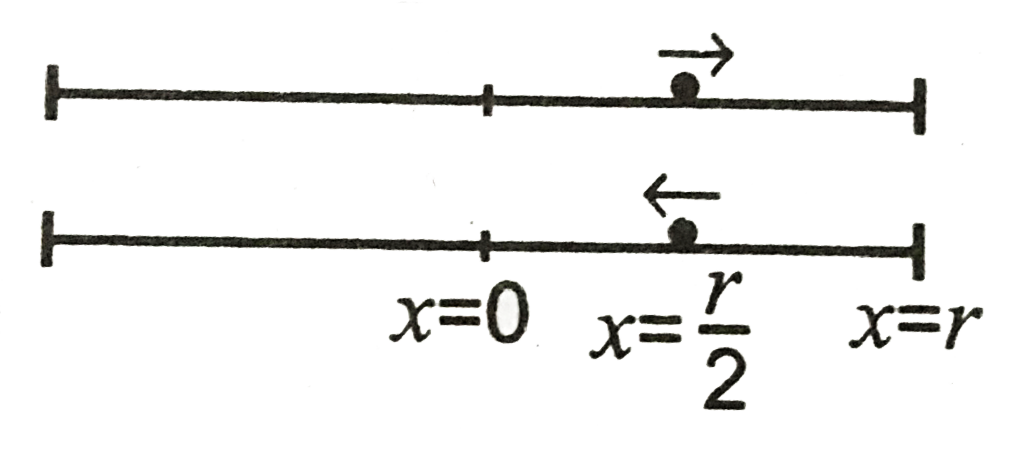Two particles execute simple harmonic motion of same amplitude and frequency along the same straight line. They pass on another, when going in opposite directions, each time their displacement is half of their amplitude. What is the phase difference between them?
In SHM, x=rsin(ωt+ϕ)
velocity, v=dxdt=rωcos(ωt+ϕ)
At t=2,x=r/s, then
r2=rsinϕorsinϕ=12=sin(π6)orsin(5π6)
∴Φ=π6or5π6
If ϕ=π6, displacement and velocity both are positive at t=0 when ϕ=5π6 , displacement is positive and velocity is negative, Figure,
Therefore, displacement-time equations of two particles will be x1=rsin(ωt−π/6)
x2=rsin(ωt+5π/6)
Phase difference
dϕ=5π6−π6=4π6=2π3rad

Topper's Solved these Questions
- OSCILLATIONS AND WAVESBook:PRADEEPChapter:OSCILLATIONS AND WAVESExercise:Multiple Choice Question-I
Explore 21 Videos
- OSCILLATIONS AND WAVESBook:PRADEEPChapter:OSCILLATIONS AND WAVESExercise:Multiple Choice Question-II
Explore 14 Videos
- OSCILLATIONS AND WAVESBook:PRADEEPChapter:OSCILLATIONS AND WAVESExercise:Fill In The Blanks
Explore 20 Videos
- MATHEMATICAL TOOLSBook:PRADEEPChapter:MATHEMATICAL TOOLSExercise:Fill in the blanks
Explore 5 Videos
- PHYSICAL WORLD AND MEASUREMENTBook:PRADEEPChapter:PHYSICAL WORLD AND MEASUREMENTExercise:Competiton Focus Jee Medical Entrance
Explore 18 Videos
Similar Questions
Two particles execute SHM of same amplitude and frequency on parallel lines. They pass one another when moving in opposite directions each time their displacement is one thhird their amplitude. What is the phase difference between them?
View SolutionTwo particles execute SHMs of the same amplitude and frequency along the same straight ling. They cross one another when going in opposite direction. What is th ephase difference between them when their displacements are half of their amplitudes ?
View Solution
Knowledge Check
Two particles execute simple harmonic motion of the same amplitude and frequency along close parallel lines. They pass each other moving in opposite directions each time their displacement is half their amplitude. Their phase difference is
A5π6B4π3Cπ6D2π3Two particles executes S.H.M. of the same amplitude and frequency along the same straight line. They pass one another when going in opposite directions, each time their displacement is root three by two times amplitude. The phase difference between them is
A2π3 radBπ2 radCπ6 radDπ3 radTwo particles are oscillating along two close parallel straight lines side by side, with the same frequency and amplitudes. They pass each other, moving in opposite directions when their displacement is half of the amplitude. The phase difference is:-
Aπ6B0C2π3Dπ
The maximum seperation between two particles executing simple harmonic motion of the equal amplitude and same frequency along the same straight line and about the same mean position, is √3 times the amplitude of oscillation. IF the phase difference between them is ϕ, determine 2π/ϕ.
View SolutionTwo particles are in SHM with the same amplitude and frequency along the same line and about the same point. If the maximum separation between them is √3 times their amplitude, what is the phase difference between them?
View SolutionTwo particles are oscillating along two close parallel straight lines side by side, with the same frequency and amplitudes. They pass each other, moving in opposite directions when their displacement is half of the amplitude. The phase difference is:-
View SolutionThe phase difference between two particle executing SHM of the same amplitude and frequency along same straight line while pessing one another when going in apposition direction with equal displacement from then respectively straing about is is 2π/3 if the prass if one particle is π/6 find the displecement at this instant amplitude is A
View SolutionTwo particles execute SHM of the same time period along the same straight lines. They cross each other at the mean position while going in opposite directions. Their phase difference is
View Solution

